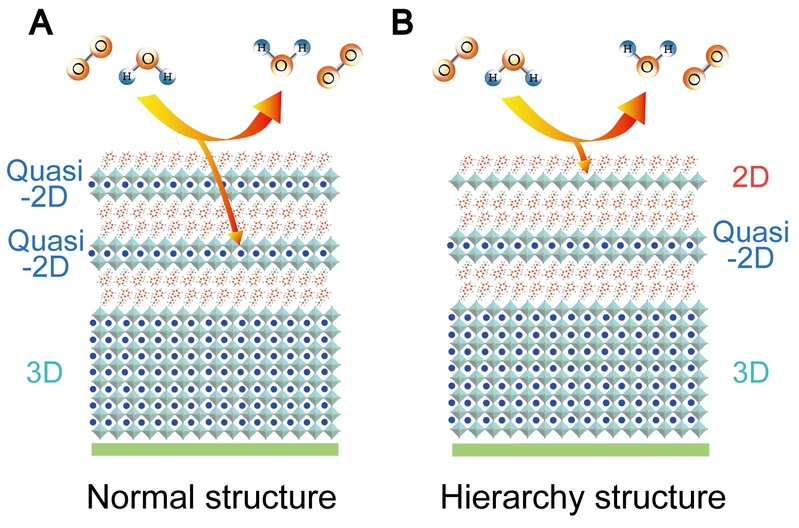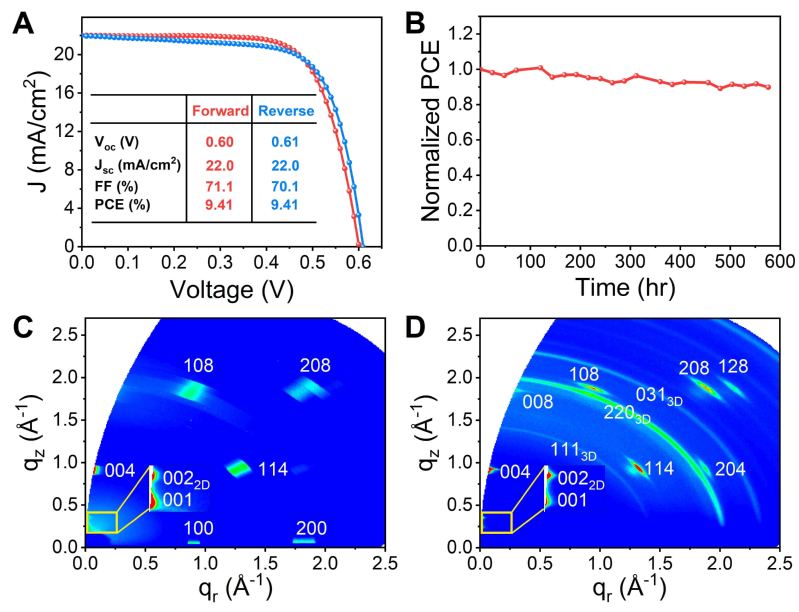Recently, School of Physical Science and Technology Professor Ning Zhijun’s research group developed a 2D-quasi-2D-3D hierarchy structural tin perovskite photovoltaic materials. Tin perovskite solar cells (PSCs) based on this structure achieved a power convention efficiency (PCE) of 9.41%, which is the highest steady-state PCE of lead-free PSCs reported up to now. Their work was recently published in Joule, titled “2D-Quasi-2D-3D Hierarchy Structure for Tin Perovskite Solar Cells with Enhanced Efficiency and Stability.”
The global energy crisis is one of the biggest challenges in the 21st century. Solar cell is one effective strategy to meet human’s energy demand. Perovskite is an ideal photovoltaic material due to its merits such as high carrier mobility, intense light absorption and low defect density. After years of development, the PSCs achieved a citified PCE of 23.3% over polysilicon solar cells. However, the toxicity of lead perovskite brings certain uncertainty to its application; the exploration of lead free perovskite materials is therefore vital to PSCs. Among the lead element subsitutes, tin (from the same group as lead in periodic table of the elements) is an ideal candidate owing to a similar shell electron structure and ideal bandgap (1.3 eV) for solar cells. Tin perovskite, however, suffers from high tin vacancy concentration and extremely poor resistance to oxidation. In their previous work, Ning’s group explored a low-dimensional tin perovskite by introducing long-chain organic molecule (phenethylamine, PEA) and achieved a PCE of 6% (J. Am. Chem. Soc. 2017, 139, 6693-6699). However, it is still a challenge to further improve the efficiency of tin PSCs due to the difficulty of controlling oxidation.
In this work, Ning’s group developed a way to manipulate the crystallization process during tin perovskite film fabrication utilizing pseudohalogen regulator ammonium thiocyanate (NH4SCN). Pseudohalogen regulator NH4SCN can separate perovskite nucleation and crystal growth processes, and NH4SCN can be removed during annealing process. In this way, they are able to build a 2D-quasi-2D-3D hierarchy structural tin perovskite film. The hierarchy structure perovskite (HSP) can enhance resistance to oxidation, decrease defect concentration and increase carrier mobility. A PCE of 9.41% of tin PSCs was achieved based on the HSP. The device retains 90% of its initial performance for almost 600 h without encapsulation during stability tracking test.
This work demonstrates that hierarchy structure can effectively reduce the oxidation of tin perovskite and improve PCE of solar cell. It also sheds some light on the structure manipulation of perovskite film by removable regulator in film fabrication.
All the work was done on this research was done by ShanghaiTech faculty and students at ShanghaiTech University. This first author is Wang Fei and the co-first author is Jiang Xianyuan, doctoral students from Professor Ning Zhijun’s research group. Transient absorption spectra was carried out by Professor Liu Weimin’s research group and master’s student Wei Jingle from Liu’s group is one of the authors. Professor Ning Zhijun is the corresponding author. ShanghaiTech University is the first responsible institution. This work was supported by National Key Research and Development Program of China, ShanghaiTech start-up funding and National Natural Science Foundation of China.
Read more at: https://www.cell.com/joule/fulltext/S2542-4351(18)30450-1

Figure 1. (A) Structure of the control film and stability schematic. (B) Structure of 2D-quasi-2D-3D hierarchy structure perovskite film and stability schematic.

Figure 2. (A) J–V curves of a HSP champion device under one sun illumination (AM1.5G,100mW/cm2). (B) Stability tracking test of HSP device stored in N2 atmosphere glovebox. (C) GIWAXS image of surface structure of HSP (the incident angle of 0.2°). (D) GIWAXS image of deep part structure of HSP (the incident angle of 2°).

